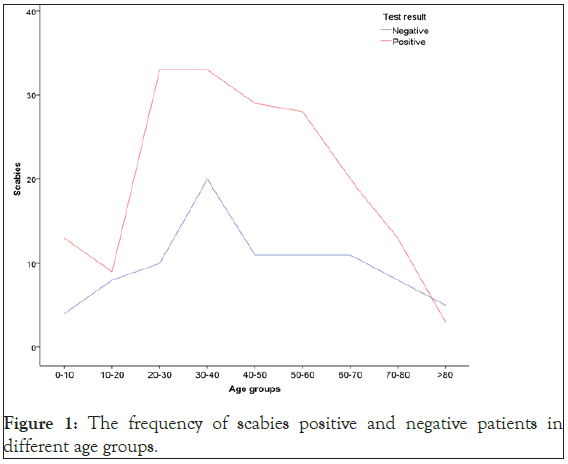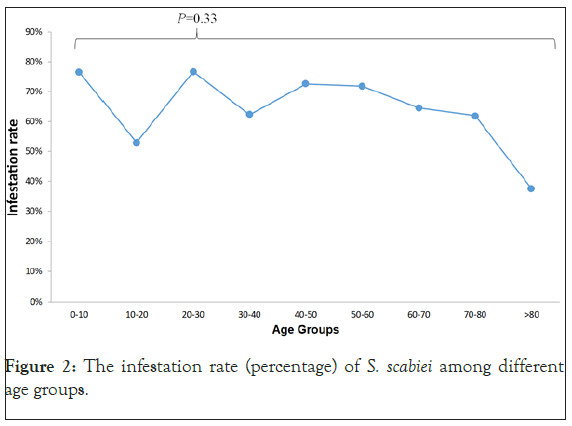Journal of Clinical & Experimental Dermatology Research
Open Access
ISSN: 2155-9554
ISSN: 2155-9554
Research Article - (2021)Volume 12, Issue 1
Purpose: Scabies is a common parasitic infestation caused by the permanent parasite of human. Infestation occurs when the "itchy" mite, S. scabiei, penetrates the skin and eats the epidermis of the host. This infestation is a major problem that occurs in many indigenous communities and less developed countries in both sexes.
Information about the prevalence of this disease in Iran is low. Thus this study aimed to determine the future of infestation in Isfahan.
Methods: 283 patients with clinical futures of scabies, who were examined by a dermatologist, from different medical centers in Isfahan, were assayed. Sampling was performed directly from the epidermis with mineral oil on the newest nodules by a scalpel blade. The specimens were examined by microscope with low and high magnification to confirm the infestation and then the results were analyzed by SPSS software v.23.
Results: With the microscopic examination, 86 (72.3%) out of 119 males and 100 (64.1%) out of 156 females with clinical futures of scabies indeed had the disease yet there was no significant statistical difference in the infestation rate with the sexes (p=0.096). Among the occupations, the highest level of infestation was observed in Artisan, 10 (71.4%) out of 14. No significant difference was observed among different occupations and the infestation rate (p=0.97).
Conclusion: The frequency of the disease in Isfahan is high, but for a more accurate assessment of the disease, more studies with the same methodology should be done to take appropriate health measures for this disease.
Sarcoptes scabiei; Scabies; Isfahan; Iran
Human scabies is a skin disease caused by Sarcoptes scabiei var. hominis. It is one of the most common itch-causing diseases that can be seen in humans and animals in most regions of the world, in all races and social classes of people. The prevalence is depending on the hosts’ age and the burden of scabies in that region. The highest prevalence is in age groups 1-4 years, followed by 5-24 years old [1].
Female Sarcoptes mite is found in areas of the body with delicate, wrinkled, and moist skin, except the head and neck, scabs under the skin, and causes the disease, scabies. The disease agent inhabits the stratum corneum of the hosts' skin and lays two to three eggs per day for up to six weeks. The severe and debilitating itching that being intense at night causes skin scratches and consequently secondary bacterial infection leading to complicated clinical symptoms and ultimately impetigo [2]. Other clinical symptoms of the disease include limited skin and soft tissue infections, skin abscesses, cellulitis and necrosis, kidney disorders, and the potential for developing rheumatic heart disease [3,4]. Sarcoptes can easily be transmitted through direct contact, especially between sexual partners; it can even be transmitted from the affected person who does not have clinical symptoms. The disease is indirectly transmitted if the clothes or beds of infected people are immediately used [5].
The chronic form of the disease is called crusted or Norwegian scabies. It occurs in people with immune deficiency, including people with diabetes, patients with HIV/AIDS, malnourished people, or those living in institutions. The infestation with this parasite is common in developing countries [6].
It is estimated that around 100 million people are affected by the disease around the world [7]. Since the frequency of scabies in different societies reflects their health status and community health. Early diagnosis of the disease is necessary for preventing complicated disease, thus we decided to accept patients from different health centers to help to diagnose the disease accurately. The present study aimed to evaluate the frequency of scabies among individuals referred to the Department of Parasitology and Mycology in Isfahan University of Medical Sciences, Isfahan, Iran, as a reference laboratory.
In this study, 283 patients with clinical futures of scabies, who were examined clinically by a dermatologist, and were referred to the Department of Parasitology in Isfahan University of Medical Sciences, from different medical centers, including Shariati and Emam Hospitals, private clinics and other health centers of Isfahan, were assayed for 12 months from December 2015 to December 2016. In this descriptive cross-sectional study, patients were clinically examined. After taking a brief history of the patient and demographics, such as age, duration of the disease, clinical signs, involved areas of the body, and underlying diseases, the direct testing for final diagnosis was done. Sampling was performed directly from the epidermis after a little rubbing of impregnated lesions with mineral oil on the newest nodules by a scalpel blade. The specimens were examined by microscope with low and high magnification for any signs of parasites, including eggs, larvae, residues, and wastes. In the end, the results were analyzed by SPSS software v.23 (IBM Corp., Armonk, N.Y., USA) using chi-square and t-tests.
Among the 283 suspected patients of scabies, 119 (43.3%) and 156 (56.7%) were males and females, respectively. Based on the microscopic examination, 192 (67.8%) and 91 (32.2%) out of 283 patients with clinical futures of scabies were positive and negative for S. scabiei, respectively. There was no significant statistical difference in the infestation rate with the sexes (Table 1).
| Sex | Scabies | Total | Odds ratio male/female | P | |
|---|---|---|---|---|---|
| Negative | Positive | ||||
| Male n (%) | 33 (27.7) | 86 (72.3) | 119 (100) | 1.127 | 0.096 |
| Female n (%) | 56 (35.9) | 100 (64.1) | 156 (100) | ||
Table 1: The infestation rate of S. scabiei among studied male and female patients.
Nineteen (9.9%) out of 192 patients with scabies had a familial infestation and also 6 (2.1%) had a history of scabies in the past and were re-infested by the mite. The mean age of the patients was 45.5 years (minimum 1 and maximum 92 years-old). Most of the studied cases were in the age group 20-40 years-old (Figure 1). However, the infestation rate was higher in patients in 0-10 and 20-30-year-old age groups, yet it was not significant (Figure 2). The mean age of the positive (42.5) and negative (45.6) cases did not show a significant statistical difference (P=0.24).

Figure 1: The frequency of scabies positive and negative patients in different age groups.

Figure 2: The infestation rate (percentage) of S. scabiei among different age groups.
The participants had different occupations, yet no significant difference was observed among different occupations and the infestation rate (Table 2).
| Job | Scabies | Total | P | |
|---|---|---|---|---|
| Negative | Positive | |||
| Employee n (%) | 13 (29.5) | 31 (70.5) | 44 (100) | 0.97 |
| Artisan n (%) | 4 (28.6) | 10 (71.4) | 14 (100) | |
| Building worker n (%) | 6 (30) | 14 (70) | 20 (100) | |
| Housewife n (%) | 38 (33.3) | 76 (66.7) | 114 (100) | |
| Retired n (%) | 12 (32.4) | 25 (67.6) | 37 (100) | |
| Student n (%) | 9 (39.1) | 14 (60.9) | 23 (100) | |
Table 2: The infestation rate of S. scabiei among patients with different occupations.
In this study, the prevalence of scabies in clinically suspected patients who were referred by dermatologists and health centers to the Parasitology and Mycology Department of Isfahan University of Medical Sciences was assayed. The results showed that nearly 68% of the patients with clinical futures of scabies indeed had the disease in Isfahan. This means that physicians should be aware that clinical examination is the first and very important step toward the diagnosis of scabies. The study of the prevalence of scabies has been carried out regularly in many countries all around the world. According to the results of various studies, the prevalence rate of diseases in the community is a reflection of the public health state [7-10]. For example, according to studies on the state of public health in these communities, it has been found that the prevalence of scabies is higher in African countries than the other continents. The prevalence of scabies in Nigeria has been 16.5%. In Malawi and Egypt, the differentiation in frequency from 1.8 to 5.6 percent is depending on the Number of family members and their economic status [11-14]. The highest prevalence of the disease in Papua New Guinea has been reported 71%, followed by Panama and Fiji (32%). The highest incidence of scabies in children is reported in Panama, 78% in children younger than two years, and 60% in children aged two to six years [7].
In 2003, Golchay et al. reported that the disease is more common in 9-year-olds with a frequency of 45% among students of primary schools in Somea-Sara, North of Iran [15]. In Ahwaz, South West of Iran, Rahdar et al. estimated that the highest prevalence of scabies occurs in children under 10 years old. Other studies have also shown that the highest prevalence of scabies was in children less than 10 years old [16]. The results of the present study are in line with the studies that reported the high prevalence of the disease in children is between one to 10 years old; however, we also observed a high prevalence of scabies in patients 20-30 years old. In Iran, the prevalence of this disease is different in various climates and the social and economic status of people [17,18].
According to the previously published studies, in Iran, the highest infestation rates have been reported in Guilan province with a 69% prevalence rate in 1997 and 87% in 1999 and Mazandaran province with 68% prevalence in 1998 [19]. It may be probably due to the high density of the population as compared to other parts of the country and high humidity in the environment. Dehghani et al. have described the highest rate of the disease in 1996 (25%) and the lowest rate in 2002 (6.5%) in Isfahan, central Iran. They have reported the incidence of scabies in males to be three times more than that of women [19].
The occurrence of the disease does not depend on sex; however, some studies have reported higher infestation rates in females and some in males [15,20]. This difference is related to the social and cultural conditions of the community. In the present study, the prevalence of infestation in males was slightly higher than that in females, but it was not even near a significant cutoff. According to the results of the present study, the most important factors to getting disease could be sex, race, age, direct contact with each other, and the level of hygiene undoubtedly. Living in crowded places with a low level of hygiene raises the risk of infestation, and health care officials should consider the health education of the people.
According to available information, the prevalence of scabies in Iran is relatively high. In the current study, nearly 68% of the tested people were positive, which is considerably high. Various studies have used several different samples according to the type of study.
According to the results of the present study, about two-thirds of the patients with clinical futures of scabies had the disease in Isfahan. This means that physicians should be aware that clinical examination is the first and very important step toward the diagnosis of scabies. Furthermore, the disease is not strongly related to sex, age, and even occupation.
Citation: Kalantari R, Soleimanifard S, Soleimani-Ahmadi M, Jafari R (2021) Study on the Prevalence of Scabies among Patients with Clinical Futures of the Disease in Isfahan, Iran. J Clin Exp Dermatol Res. 12:554.
Received: 27-Jan-2021 Accepted: 10-Feb-2021 Published: 17-Feb-2021 , DOI: 10.35248/2155-9554.21.12.554
Copyright: © 2021 Kalantari R, et al. This is an open-access article distributed under the terms of the Creative Commons Attribution License, which permits unrestricted use, distribution, and reproduction in any medium, provided the original author and source are credited.